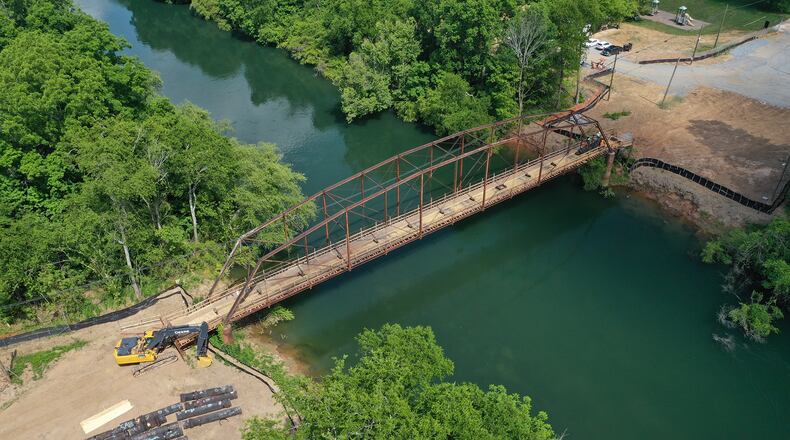A historic bridge that dates back to the early 1900s and connects two counties will soon be demolished, but its parts will continue on.
Ten tons of salvaged steel from the historic Rogers Bridge over the Chattahoochee River will be evenly divided between Johns Creek in Fulton County and Duluth in Gwinnett County for each city to use or distribute to the public. Officials have said the bridge materials could be used for public art or for people to use for business operations or construction.
Rogers Bridge is located in its namesake park in Duluth. Built in 1911, the old steel bridge has been closed to vehicles for approximately 40 years. A new pedestrian bridge will take its place, connecting Rogers Bridge Park in Gwinnett County to Johns Creek’s future Cauley Creek Park in Fulton County.
Construction crews are slated to start tearing down Rogers Bridge in the fall, Johns Creek Communications Manager Bob Mullen said. They will build a $7.2 million replica of the original that will be a pedestrian bridge. It’s expected to be finished by late fall 2022.
Crews broke ground in March for the joint project between Duluth, Johns Creek, Gwinnett and Fulton counties. Each city and county is contributing $350,000 toward construction cost and splitting the $700,000 cost of engineering and design. The Atlanta Regional Commission is contributing $5.1 million.
Johns Creek and Duluth will each receive 5 tons of salvaged steel. Salvaged pieces would range from 11 to15 feet in length, Johns Creek Engineer Erica Madsen said in a June memo to Mayor Mike Bodker and City Council.
The steel has generated wide interest in the community. Nonprofits such as Johns Creek Convention and Visitors Bureau and Johns Creek Arts Center, as well as commercial business have requested the material, Madsen said.
Johns Creek City Council plans to discuss what they will do with their half of the salvage and a possible application process for the public during a Monday work session.
Madsen said in her memo, “Because the salvage cost of the steel exceeds the value of the asset, it can be given away without a public auction (typically required when government goods are removed from inventory).”
Madsen estimates cutting the salvaged steel into manageable pieces and moving it to a storage location will cost the city about $20,000.
Joan Compton, president and co-founder of the Johns Creek Historical Society, wants the city to keep the steel and turn it into art pieces for Cauley Creek Park.
“My suggestion is don’t be hasty in giving it away,” Compton said. Once it’s gone, it’s gone. We have very little history (in Johns Creek) and this is a big deal.”
The 228-foot bridge was named after the Rogers family, who operated a ferry system across the Chattahoochee River. It was built to replace the ferry system to transport cotton over the river — and fell into disuse in the 1970s, Margie Pozin, city engineer for Duluth, told the AJC in March.
At one time, Rogers Bridge was one of seven such bridges in the area that is now Johns Creek, she added.
The city plans to do what Compton has in mind and have the salvaged steel transformed into public art by the Duluth Public Art Commission, Duluth Economic Development Director Chris McGahee said.
Harmful paint and lead will be removed from the salvaged steel before it’s in the public’s hands, McGahee added.
About the Author
The Latest
Featured



